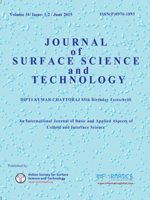Excess Adsorption of Hemoglobin at Solid-Liquid Interfaces
Subscribe/Renew Journal
The adsorption of oligomeric protein, hemoglobin from aqueous solution to the surfaces of silica, alumina, chromium, resin (Cl- form), carbon and sephadex have been studied as functions of bulk aqueous protein concentrations at various values of pH, ionic strength and temperature of the system. The shape and monolayer points of the adsorption isotherms have been analysed and factors responsible for positive and negative adsorption of hemoglobin at different surfaces have been discussed. The low values of maximum adsorption of hemoglobin obtained for several types of surfaces indicates that the quaternary structure of four polypeptide chains of the oligomeric protein are probably broken at the interface and the protein is adsorbed as a single polypeptide chain having tertiary structure close to that of myoglobin. Further, using an universal scale of thermodynamics, an attempt has been made to explain and compare the maximum affinities for different surfaces in terms of standard free energies (ΔG0) of adsorption per square meter of the surface. The standard free energy (ΔG0B) for the transfer of one mole of protein from bulk water to the surface is observed to be ±40 kJ/mol and this value is independent of pH, ionic strength and temperature.
Keywords
Adsorption, Hemoglobin, Monolayer, Silica, Alumina, Chromium, Carbon, Sephadex, Adsorption Isotherm.
Subscription
Login to verify subscription
User
Font Size
Information

Abstract Views: 177

PDF Views: 1



